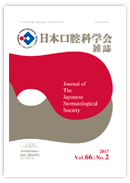All issues

Volume 66, Issue 2
Displaying 1-17 of 17 articles from this issue
- |<
- <
- 1
- >
- >|
-
2017 Volume 66 Issue 2 Pages 57
Published: 2017
Released on J-STAGE: July 18, 2017
JOURNAL RESTRICTED ACCESSDownload PDF (58K)
-
Tanguy Y. Seiwert2017 Volume 66 Issue 2 Pages 59
Published: 2017
Released on J-STAGE: July 18, 2017
JOURNAL RESTRICTED ACCESSImmunotherapy, enabling a patient's own immune system to attack a cancer, is a novel treatment modality that has shown activity in more than 20 cancer types. Head and neck cancers show a prominent inflamed phenotype with tumor infiltrating lymphocytes, and is amenable to immunotherapy.
Specifically, immune checkpoint inhibitors, such as those blocking the interaction of PD-1 and PD-L1 have shown marked activity in recurrent/metastatic head and neck cancer, including oral cavity tumors. Responses are oftentimes more durable than what is observed with chemotherapy or targeted therapies, and the impact on survival is pronounced compared to standard treatments. Combined with a favorable toxicity profile PD-1 agents have been approved in the US for treatment of head and neck cancer.
This presentation will provide an overview of available clinical data from multiple agents, and outline how to best use these novel medications, as well as a discuss side effect management, and patient selection/candidate biomarkers.
Furthermore, while PD-1/PD-L1checkpoint blockade is active in HNC and non-cross-resistant with other treatment modalities, much remains unknown: I will review strategies and ongoing trials, attempting to integrate immunotherapy in earlier lines of therapy, including curative intent, and adjuvant therapy. I will specifically review how immunotherapy may be complementary with surgical care, as well as potentially radiation, and chemo-prevention.
Finally we will look ahead at upcoming second generation combination immunotherapy approaches, with early data suggesting that continued progress is ahead for our patients with oral cavity cancers and head and neck cancers in general.View full abstractDownload PDF (487K)
-
[in Japanese]2017 Volume 66 Issue 2 Pages 60
Published: 2017
Released on J-STAGE: July 18, 2017
JOURNAL RESTRICTED ACCESS
-
[in Japanese]2017 Volume 66 Issue 2 Pages 61
Published: 2017
Released on J-STAGE: July 18, 2017
JOURNAL RESTRICTED ACCESS
-
[in Japanese]2017 Volume 66 Issue 2 Pages 62
Published: 2017
Released on J-STAGE: July 18, 2017
JOURNAL RESTRICTED ACCESS
-
[in Japanese]2017 Volume 66 Issue 2 Pages 63
Published: 2017
Released on J-STAGE: July 18, 2017
JOURNAL RESTRICTED ACCESS
-
[in Japanese]2017 Volume 66 Issue 2 Pages 64
Published: 2017
Released on J-STAGE: July 18, 2017
JOURNAL RESTRICTED ACCESS
-
[in Japanese]2017 Volume 66 Issue 2 Pages 65
Published: 2017
Released on J-STAGE: July 18, 2017
JOURNAL RESTRICTED ACCESS
-
[in Japanese]2017 Volume 66 Issue 2 Pages 66
Published: 2017
Released on J-STAGE: July 18, 2017
JOURNAL RESTRICTED ACCESS -
[in Japanese]2017 Volume 66 Issue 2 Pages 67
Published: 2017
Released on J-STAGE: July 18, 2017
JOURNAL RESTRICTED ACCESS
-
2017 Volume 66 Issue 2 Pages 68-74
Published: 2017
Released on J-STAGE: July 18, 2017
JOURNAL RESTRICTED ACCESSDownload PDF (553K)
-
2017 Volume 66 Issue 2 Pages 75-83
Published: 2017
Released on J-STAGE: July 18, 2017
JOURNAL RESTRICTED ACCESSDownload PDF (653K)
-
2017 Volume 66 Issue 2 Pages 84-85
Published: 2017
Released on J-STAGE: July 18, 2017
JOURNAL RESTRICTED ACCESSDownload PDF (308K)
-
2017 Volume 66 Issue 2 Pages 86-87
Published: 2017
Released on J-STAGE: July 18, 2017
JOURNAL RESTRICTED ACCESSDownload PDF (237K)
-
2017 Volume 66 Issue 2 Pages 88-91
Published: 2017
Released on J-STAGE: July 18, 2017
JOURNAL RESTRICTED ACCESSDownload PDF (384K)
-
2017 Volume 66 Issue 2 Pages 92-145
Published: 2017
Released on J-STAGE: July 18, 2017
JOURNAL RESTRICTED ACCESSDownload PDF (2245K)
-
2017 Volume 66 Issue 2 Pages 146-209
Published: 2017
Released on J-STAGE: July 18, 2017
JOURNAL RESTRICTED ACCESSDownload PDF (2628K)
- |<
- <
- 1
- >
- >|